Machine Learning for Fog-and-Low-Stratus Nowcasting from Meteosat SEVIRI Satellite Images
Abstract
1. Introduction
2. Materials and Methods
2.1. FLS Climatology over the Study Area
2.2. Datasets
2.3. Optical Flow Techniques
- and are the illumination at two timesteps and ;
- x and y describe the location;
- and are the small translations along x and y;
- is the difference between the two timesteps and .
2.4. Deep Learning Techniques
2.4.1. Formulation of Fog/Low-Stratus Nowcasting Problem
2.4.2. Design of Training, Validation and Testing Datasets
2.4.3. Hyperparameter Tuning
2.5. Diagnostic Metrics
2.5.1. Mean Squared Error (MSE)
2.5.2. Structural Similarity Index Measure (SSIM)
- the average of x;
- the average of y;
- the variance of x;
- the variance of y;
- the covariance of x and y;
- two variables to stabilize the division with weak denominator;
- L the dynamic range of the pixel values (typically, this is ;
- and by default.
3. Results
3.1. Hyperparameter Tuning
3.1.1. Sensitivity of Optical Flow Techniques to Mask Definition
3.1.2. Tuning the Number of Filters for Deep Learning Models
3.2. Case Study: Optical Flow Techniques Performance
3.3. Case Study: Deep Learning Techniques Performance
3.4. Global Performance Assessment over the Test Data Set
4. Discussion
5. Conclusions
- 1.
- ConvLSTM outperforms conventional CNN and Unet algorithms and state-of-the art of optical flow techniques (sparse and dense) over all lead times. This method is superior in terms of both MSE and SSIM metrics with values of about 0.3 and 0.6, respectively.
- 2.
- The DL algorithms can better model the nonlinear processes of the evolution of FLS event and produce more reasonable and location-accurate nowcasts. A representative case study qualitatively illustrates that DL models can better model the spatiotemporal evolution of FLS event and its coverage by mid-level clouds and produce more reasonable nowcasts, while the optical flow techniques fails in reproducing this configuration.
- 3.
- The sparse optical flow technique showed high sensitivity to the mask definition on the area of interest and also the target phenomenon, while for deep learning techniques, it was found that the number of filters tuning has an impact on the performance of the DL-based models.
Supplementary Materials
Author Contributions
Funding
Institutional Review Board Statement
Informed Consent Statement
Data Availability Statement
Acknowledgments
Conflicts of Interest
References
- Leigh, R.J.; Drake, L.; Thampapillai, D.J. An Economic Analysis of Terminal Aerodrome Forecasts with Special Reference to Sydney Airport. J. Transp. Econ. Policy 1998, 55, 1731–1745. [Google Scholar]
- Pagowski, M.; Gultepe, I.; King, P. Analysis and Modeling of an Extremely Dense Fog Event in Southern Ontario. J. Appl. Meteorol. 2004, 43, 3–16. [Google Scholar] [CrossRef]
- Kneringer, P.; Dietz, S.J.; Mayr, G.J.; Zeileis, A. Probabilistic nowcasting of low-visibility procedure states at Vienna International Airport during cold season. Pure Appl. Geophys. 2019, 176, 2165–2177. [Google Scholar] [CrossRef]
- Dietz, S.J.; Kneringer, P.; Mayr, G.J.; Zeileis, A. Low-visibility forecasts for different flight planning horizons using tree-based boosting models. Adv. Stat. Climatol. Meteorol. Oceanogr. 2019, 5, 101–114. [Google Scholar] [CrossRef]
- Haeffelin, M.; Bergot, T.; Elias, T.; Tardif, R.; Carrer, D.; Chazette, P.; Colomb, M.; Drobinski, P.; Dupont, E.; Dupont, J.-C.; et al. Parisfog. Bull. Am. Meteorol. Soc. 2010, 91, 767–783. [Google Scholar] [CrossRef]
- Wang, Y.; Niu, S.; Lu, C.; Lv, J.; Zhang, J.; Zhang, H.; Shao, N.; Sun, W.; Jin, Y.; Song, Q. Observational study of the physical and chemical characteristics of the winter radiation fog in the tropical rainforest in Xishuangbanna, China. Sci. China Earth Sci. 2021, 64, 1982–1995. [Google Scholar] [CrossRef]
- Wang, Y.; Lu, C.; Niu, S.; Lv, J.; Jia, X.; Xu, X.; Xue, Y.; Zhu, L.; Yan, S. Diverse dispersion effects and parameterization of relative dispersion in urban fog in eastern China. J. Geophys. Res. Atmos. 2023, 128, e2022JD037514. [Google Scholar] [CrossRef]
- Bari, D.; Bergot, T.; El Khlifi, M. Local meteorological and large-scale weather characteristics of fog over the grand Casablanca region, morocco. J. Appl. Meteorol. Climatol. 2016, 55, 1731–1745. [Google Scholar] [CrossRef]
- Kim, W.; Yum, S.S.; Hong, J.; Song, J.I. Improvement of Fog Simulation by the Nudging of Meteorological Tower Data in the WRF and PAFOG Coupled Model. Atmosphere 2020, 11, 311. [Google Scholar] [CrossRef]
- Liu, Q.; Wu, B.; Wang, Z.; Hao, T. Fog Droplet Size Distribution and the Interaction between Fog Droplets and Fine Particles during Dense Fog in Tianjin, China. Atmosphere 2020, 11, 258. [Google Scholar] [CrossRef]
- Leung, A.C.W.; Gough, W.A.; Butler, K.A. Changes in Fog, Ice Fog, and Low Visibility in the Hudson Bay Region: Impacts on Aviation. Atmosphere 2020, 11, 186. [Google Scholar] [CrossRef]
- Bari, D.; Bergot, T.; El Khlifi, M. Numerical study of a coastal fog event over casablanca, morocco. Q. J. R. Meteorol. Soc. 2015, 141, 1894–1905. [Google Scholar] [CrossRef]
- Boutle, I.; Angevine, W.; Bao, J.-W.; Bergot, T.; Bhattacharya, R.; Bott, A.; Ducongé, L.; Forbes, R.; Goecke, T.; Grell, E.; et al. Demistify: A large-eddy simulation (LES) and single-column model (SCM) intercomparison of radiation fog. Atmos. Chem. Phys. 2022, 22, 319–333. [Google Scholar] [CrossRef]
- Bergot, T.; Koracin, D. Observation, simulation and predictability of fog: Review and perspectives. Atmosphere 2021, 12, 235. [Google Scholar] [CrossRef]
- Cermak, J.; Bendix, J. Dynamical nighttime fog/low stratus detection based on Meteosat SEVIRI data: A feasibility study. Pure Appl. Geophys. 2007, 164, 1179–1192. [Google Scholar] [CrossRef]
- Gautam, R.; Singh, M.K. Urban Heat Island Over Delhi Punches Holes in Widespread Fog in the Indo-Gangetic Plains. Geophys. Res. Lett. 2018, 45, 1114–1121. [Google Scholar] [CrossRef]
- Fuchs, J.; Andersen, H.; Cermak, J.; Pauli, E.; Roebeling, R. High-resolution satellite-based cloud detection for the analysis of land surface effects on boundary layer clouds. Atmos. Meas. Tech. 2022, 15, 4257–4270. [Google Scholar] [CrossRef]
- Egli, S.; Thies, B.; Drönner, J.; Cermak, J.; Bendix, J.; Thies, B.; Bendix, J. A 10 year fog and low stratus climatology for Europe based on Meteosat Second Generation data. Q. J. R. Meteorol. Soc. 2017, 143, 530–541. [Google Scholar] [CrossRef]
- Bari, D.; El Khlifi, M. LVP conditions at Mohamed v airport, Morocco: Local characteristics and prediction using neural networks. Int. J. Basic Appl. Sci. 2015, 4, 354. [Google Scholar] [CrossRef]
- Dueben, P.; Bauer, P. Challenges and design choices for global weather and climate models based on machine learning. Geosci. Model Dev. 2018, 11, 3999–4009. [Google Scholar] [CrossRef]
- Chkeir, S.; Anesiadou, A.; Mascitelli, A.; Biondi, R. Nowcasting extreme rain and extreme wind speed with machine learning techniques applied to different input datasets. Atmos. Res. 2023, 282, 106548. [Google Scholar] [CrossRef]
- Bari, D. Visibility prediction based on kilometric nwp model outputs using machine-learning regression. In Proceedings of the 2018 IEEE 14th International Conference on e-Science (e-Science), Amsterdam, The Netherlands, 29 October–1 November 2018; p. 278. [Google Scholar]
- Bari, D.; Ouagabi, A. Machine-learning regression applied to diagnose horizontal visibility from mesoscale nwp model forecasts. SN Appl. Sci. 2020, 2, 1–13. [Google Scholar] [CrossRef]
- Ravuri, S.; Lenc, K.; Willson, M.; Kangin, D.; Lam, R.; Mirowski, P.; Fitzsimons, M.; Athanassiadou, M.; Kashem, S.; Madge, S.; et al. Skilful precipitation nowcasting using deep generative models of radar. Nature 2021, 597, 672–677. [Google Scholar] [CrossRef] [PubMed]
- Lam, R.; Sanchez-Gonzalez, A.; Willson, M.; Wirnsberger, P.; Fortunato, M.; Pritzel, A.; Ravuri, S.; Ewalds, T.; Alet, F.; Eaton-Rosen, Z.; et al. GraphCast: Learning skillful medium-range global weather forecasting. arXiv 2022, arXiv:2212.12794. [Google Scholar]
- Pritt, M.; Chern, G. Satellite image classification with deep learning. In Proceedings of the 2017 IEEE Applied Imagery Pattern Recognition Workshop (AIPR), Washington, DC, USA, 10–12 October 2017; pp. 1–7. [Google Scholar]
- Alkhelaiwi, M.; Boulila, W.; Ahmad, J.; Koubaa, A.; Driss, M. An efficient approach based on privacy-preserving deep learning for satellite image classification. Remote Sens. 2021, 13, 2221. [Google Scholar] [CrossRef]
- Zhang, P.; Ke, Y.; Zhang, Z.; Wang, M.; Li, P.; Zhang, S. Urban land use and land cover classification using novel deep learning models based on high spatial resolution satellite imagery. Sensors 2018, 18, 3717. [Google Scholar] [CrossRef] [PubMed]
- Pan, Z.; Xu, J.; Guo, Y.; Hu, Y.; Wang, G. Deep learning segmentation and classification for urban village using a worldview satellite image based on U-Net. Remote Sens. 2020, 12, 1574. [Google Scholar] [CrossRef]
- Li, L.; He, Z.; Chen, S.; Mai, X.; Zhang, A.; Hu, B.; Li, Z.; Tong, X. Subpixel-Based Precipitation Nowcasting with the Pyramid Lucas–Kanade Optical Flow Technique. Atmosphere 2018, 9, 260. [Google Scholar] [CrossRef]
- Le Goff, M.; Tourneret, J.Y.; Wendt, H.; Ortner, M.; Spigai, M. Deep learning for cloud detection. In Proceedings of the 8th International Conference of Pattern Recognition Systems ICPRS, Madrid, Spain, 11–13 July 2017; pp. 1–6. [Google Scholar]
- Zhang, J.; Lu, H.; Xia, Y.; Han, T.; Miao, K.; Yao, Y.; Liu, C.; Zhou, J.P.; Chen, P.; Wang, B. Deep convolutional neural network for fog detection. In Intelligent Computing Theories and Application, Proceedings of the 14th International Conference on Intelligent Computing, Wuhan, China, 15–18 August 2018; Springer: Berlin/Heidelberg, Germany, 2018; pp. 1–10. [Google Scholar]
- Guo, S.; Sun, N.; Pei, Y.; Li, Q. 3D-UNet-LSTM: A Deep Learning-Based Radar Echo Extrapolation Model for Convective Nowcasting. Remote Sens. 2023, 15, 1529. [Google Scholar] [CrossRef]
- Shi, X.; Chen, Z.; Wang, H.; Yeung, D.Y.; Wong, W.K.; Woo, W.C. Convolutional LSTM network: A machine learning approach for precipitation nowcasting. Adv. Neural Inf. Process. Syst. 2015, 28, 1–9. [Google Scholar]
- Petrou, Z.I.; Tian, Y. Prediction of sea ice motion with convolutional long short-term memory networks. IEEE Trans. Geosci. Remote. Sens. 2019, 57, 6865–6876. [Google Scholar] [CrossRef]
- Tan, C.; Feng, X.; Long, J.; Geng, L. Forecast-CLSTM: A new convolutional lstm network for cloudage nowcasting. In Proceedings of the 2018 IEEE Visual Communications and Image Processing (VCIP), Taichung, Taiwan, 9–12 December 2018; pp. 1–4. [Google Scholar]
- Guo, Y.; Cao, X.; Liu, B.; Gao, M. Cloud detection for satellite imagery using attention-based u-net convolutional neural network. Symmetry 2018, 12, 1056. [Google Scholar] [CrossRef]
- Leese, J.A.; Novak, C.S.; Taylor, V.R. The determination of cloud pattern motions from geosynchronous satellite image data. Pattern Recognit. 1970, 2, 279–292. [Google Scholar] [CrossRef]
- Ayzel, G.; Heistermann, M.; Winterrath, T. Optical flow models as an open benchmark for radar-based precipitation nowcasting (rainymotion v0. 1), Geosci. Model Dev. 2019, 12, 1387–1402. [Google Scholar] [CrossRef]
- Marrocu, M.; Massidda, L. Performance Comparison between Deep Learning and Optical Flow-Based Techniques for Nowcast Precipitation from Radar Images. Forecasting 2020, 2, 194–210. [Google Scholar] [CrossRef]
- Wood-Bradley, P.; Zapata, J.; Pye, J. Cloud tracking with optical flow for short-term solar forecasting. In Proceedings of the 50th Conference of the Australian Solar Energy Society, Melbourne, Australia, 10–11 October 2012. [Google Scholar]
- Mondragón, R.; Alonso-Montesinos, J.; Riveros-Rosas, D.; Bonifaz, R. Determination of cloud motion applying the Lucas-Kanade method to sky cam imagery. Remote Sens. 2020, 12, 2643. [Google Scholar] [CrossRef]
- Zaher, A.Y.; Ghanem, A. Clouds motion estimation from ground-based sky camera and satellite images. In Colorimetry and Image Processing; IntechOpen: London, UK, 2017. [Google Scholar]
- Nguyen, T.X.B.; Rosser, K.; Chahl, J. A Comparison of Dense and Sparse Optical Flow Techniques for Low-Resolution Aerial Thermal Imagery. J. Imaging 2022, 8, 116. [Google Scholar] [CrossRef]
- Wu, H.; Zhao, R.; Gan, X.; Ma, X. Measuring surface velocity of water flow by dense optical flow method. Water 2019, 11, 2320. [Google Scholar] [CrossRef]
- Bari, D.; Bergot, T. Influence of Environmental Conditions on Forecasting of an Advection-Radiation Fog: A Case Study from the Casablanca Region, Morocco. Aerosol Air Qual. Res. 2018, 18, 62–78. [Google Scholar] [CrossRef]
- Gu, J.; Wang, Z.; Kuen, J.; Ma, L.; Shahroudy, A.; Shuai, B.; Liu, T.; Wang, W.; Wang, G.; Cai, J.; et al. Recent advances in convolutional neural networks. Pattern Recognit. 2018, 77, 354–377. [Google Scholar] [CrossRef]
- Yu, Y.; Si, X.; Hu, C.; Zhang, J. A review of recurrent neural networks: LSTM cells and network architectures. Neural Comput. 2019, 31, 1235–1270. [Google Scholar] [CrossRef] [PubMed]
- Ajit, A.; Acharya, K.; Samanta, A. A review of convolutional neural networks. In Proceedings of the 2020 International Conference on Emerging Trends in Information Technology and Engineering (IC-ETITE), Vellore, India, 24–25 February 2020; pp. 1–5. [Google Scholar]
- Knippertz, P.; Christoph, M.; Speth, P. Long-term precipitation variability in Morocco and the link to the large-scale circulation in recent and future climates. Meteorol. Atmos. Phys. 2003, 83, 67–88. [Google Scholar] [CrossRef]
- Driouech, F.; Déqué, M.; Mokssit, A. Numerical simulation of the probability distribution function of precipitation over Morocco. Clim. Dyn. 2009, 32, 1055–1063. [Google Scholar] [CrossRef]
- Tramblay, Y.; El Adlouni, S.; Servat, E. Trends and variability in extreme precipitation indices over North Africa. Nat. Hazards Earth Syst. Sci. 2013, 13, 3235–3248. [Google Scholar] [CrossRef]
- Schilling, J.; Hertig, E.; Tramblay, Y.; Scheffran, J. Climate change vulnerability, water resources and social implications in North Africa. Reg. Environ. Chang. 2020, 20, 15. [Google Scholar] [CrossRef]
- Eguchi, N.; Hayasaka, T.; Sawada, M. Maritime-continental contrasts in the properties of low-level clouds: A case study of the summer of the 2003 Yamase, Japan, cloud event. Adv. Meteorol. 2014, 2014, 1–16. [Google Scholar] [CrossRef]
- Cropper, T.E.; Hanna, E.; Bigg, G.R. Spatial and temporal seasonal trends in coastal upwelling off Northwest Africa, 1981–2012. Deep. Sea Res. Part Oceanogr. Res. Pap. 2014, 86, 94–111. [Google Scholar] [CrossRef]
- Hoese, D. SatPy: A Python Library for Weather Satellite Processing. In Proceedings of the 99th American Meteorological Society Annual Meeting, AMS, Madison, WI, USA, 8 January 2019. [Google Scholar]
- Fleet, D.; Weiss, Y. Optical flow estimation. In Handbook of Mathematical Models in Computer Vision; Springer: Berlin/Heidelberg, Germany, 2006; pp. 237–257. [Google Scholar]
- Zhai, M.; Xiang, X.; Lv, N.; Kong, X. Optical flow and scene flow estimation: A survey. Pattern Recognit. 2021, 114, 107861. [Google Scholar] [CrossRef]
- Kaplan, G.; Comert, R.; Kaplan, O.; Matci, D.K.; Avdan, U. Using Machine Learning to Extract Building Inventory Information Based on LiDAR Data. ISPRS Int. J. Geo-Inf. 2022, 11, 517. [Google Scholar] [CrossRef]
- Moskolaï, W.R.; Abdou, W.; Dipanda, A. Application of deep learning architectures for satellite image time series prediction: A review. Remote Sens. 2021, 13, 4822. [Google Scholar] [CrossRef]
- Valdivia-Bautista, S.M.; Domínguez-Navarro, J.A.; Pérez-Cisneros, M.; Vega-Gómez, C.J.; Castillo-Téllez, B. Artificial Intelligence in Wind Speed Forecasting: A Review. Energies 2023, 16, 2457. [Google Scholar] [CrossRef]
- Naranjo-Torres, J.; Mora, M.; Hernández-García, R.; Barrientos, R.J.; Fredes, C.; Valenzuela, A. A review of convolutional neural network applied to fruit image processing. Appl. Sci. 2020, 10, 3443. [Google Scholar] [CrossRef]
- Yang, L.; Shami, A. On hyperparameter optimization of machine learning algorithms: Theory and practice. Neurocomputing 2020, 415, 295–316. [Google Scholar] [CrossRef]
- Xiao, X.; Yan, M.; Basodi, S.; Ji, C.; Pan, Y. Efficient hyperparameter optimization in deep learning using a variable length genetic algorithm. arXiv 2020, arXiv:2006.12703. [Google Scholar]
- Wang, Z.; Bovik, A.C.; Sheikh, H.R.; Simoncelli, E.P. Image quality assessment: From error visibility to structural similarity. IEEE Trans. Image Process. 2004, 13, 600–612. [Google Scholar] [CrossRef]
- Li, Y.; Zhang, H.; Xue, X.; Jiang, Y.; Shen, Q. Deep learning for remote sensing image classification: A survey. Wiley Interdiscip. Rev. Data Min. Knowl. Discov. 2018, 8, e1264. [Google Scholar] [CrossRef]
- Berthomier, L.; Pradel, B.; Perez, L. Cloud cover nowcasting with deep learning. In Proceedings of the 2020 Tenth International Conference on Image Processing Theory, Tools and Applications (IPTA), Paris, France, 9–12 November 2020; pp. 1–6. [Google Scholar]
- Simonyan, K.; Zisserman, A. Very deep convolutional networks for large-scale image recognition. arXiv 2014, arXiv:1409.1556. [Google Scholar]
- He, K.; Zhang, X.; Ren, S.; Sun, J. Deep residual learning for image recognition. In Proceedings of the 2016 IEEE Conference on Computer Vision and Pattern Recognition, Las Vegas, NV, USA, 27–30 June 2016; pp. 770–778. [Google Scholar]
- Balti, H.; Abbes, A.B.; Mellouli, N.; Farah, I.R.; Sang, Y.; Lamolle, M. A review of drought monitoring with big data: Issues, methods, challenges and research directions. Ecol. Inform. 2020, 60, 101136. [Google Scholar] [CrossRef]
- Peng, Y.; Liu, X.; Shen, C.; Huang, H.; Zhao, D.; Cao, H.; Guo, X. An improved optical flow algorithm based on mask-r-cnn and k-means for velocity calculation. Appl. Sci. 2019, 9, 2808. [Google Scholar] [CrossRef]
- Dosovitskiy, A.; Fischer, P.; Ilg, E.; Hausser, P.; Hazirbas, C.; Golkov, V.; Brox, T. Flownet: Learning optical flow with convolutional networks. In Proceedings of the IEEE International Conference on Computer Vision, Santiago, Chile, 7–13 December 2015; pp. 2758–2766. [Google Scholar]
- Ilg, E.; Mayer, N.; Saikia, T.; Keuper, M.; Dosovitskiy, A.; Brox, T. Flownet 2.0: Evolution of optical flow estimation with deep networks. In Proceedings of the IEEE Conference on Computer Vision and Pattern Recognition, Honolulu, HI, USA, 21–26 July 2017; pp. 2462–2470. [Google Scholar]
- Weinzaepfel, P.; Revaud, J.; Harchaoui, Z.; Schmid, C. DeepFlow: Large displacement optical flow with deep matching. In Proceedings of the IEEE International Conference on Computer Vision, Sydney, Australia, 1–8 December 2013; pp. 1385–1392. [Google Scholar]


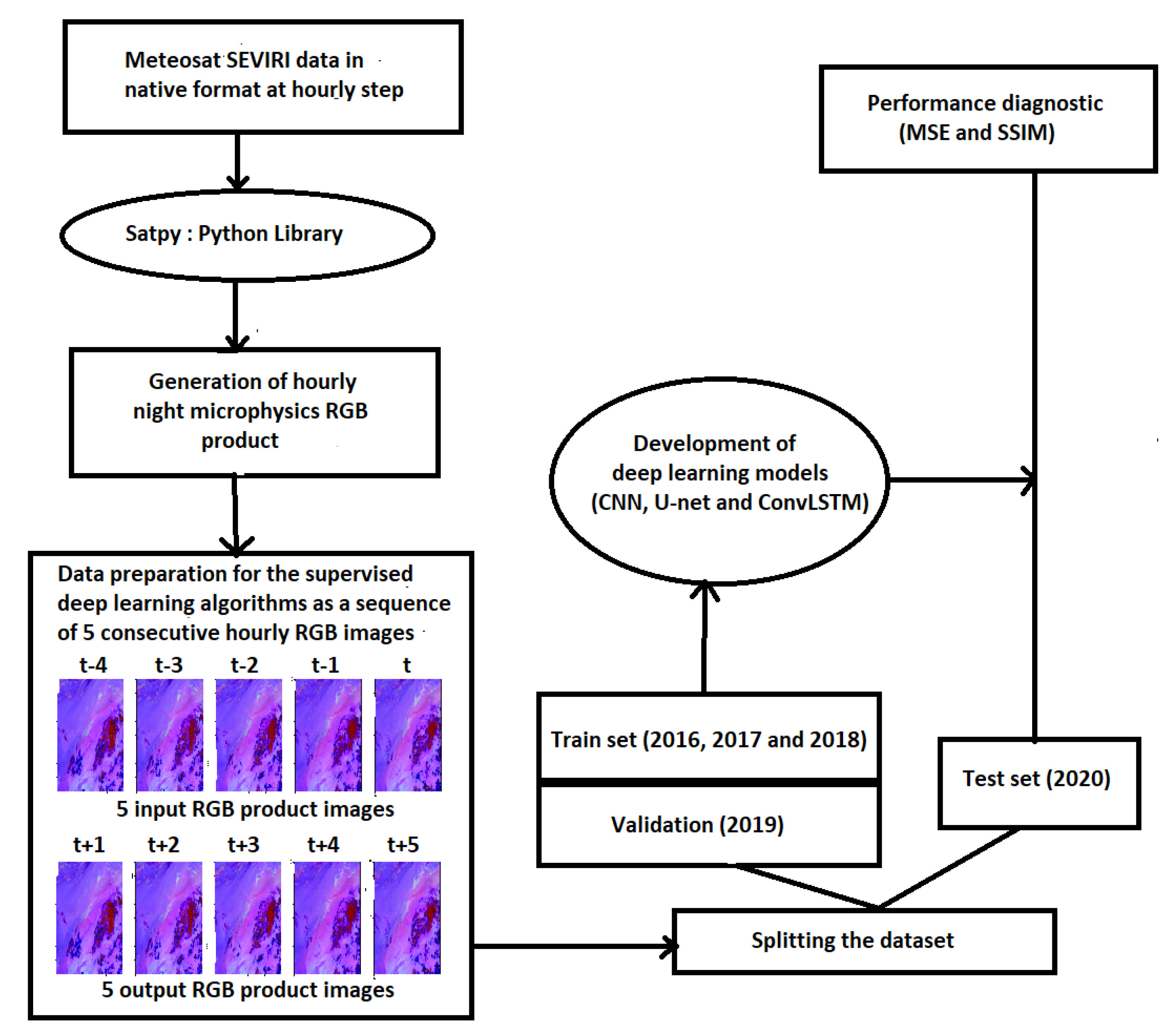
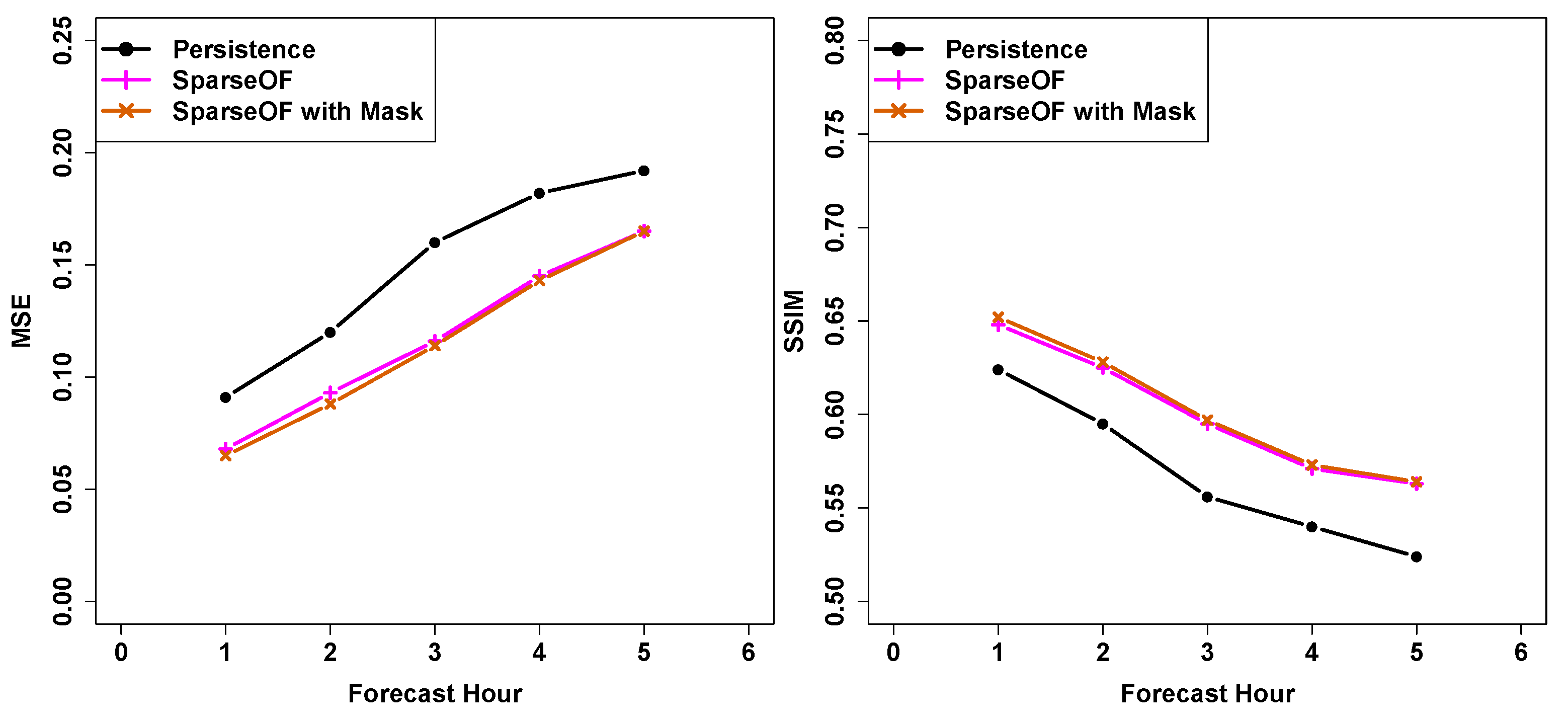


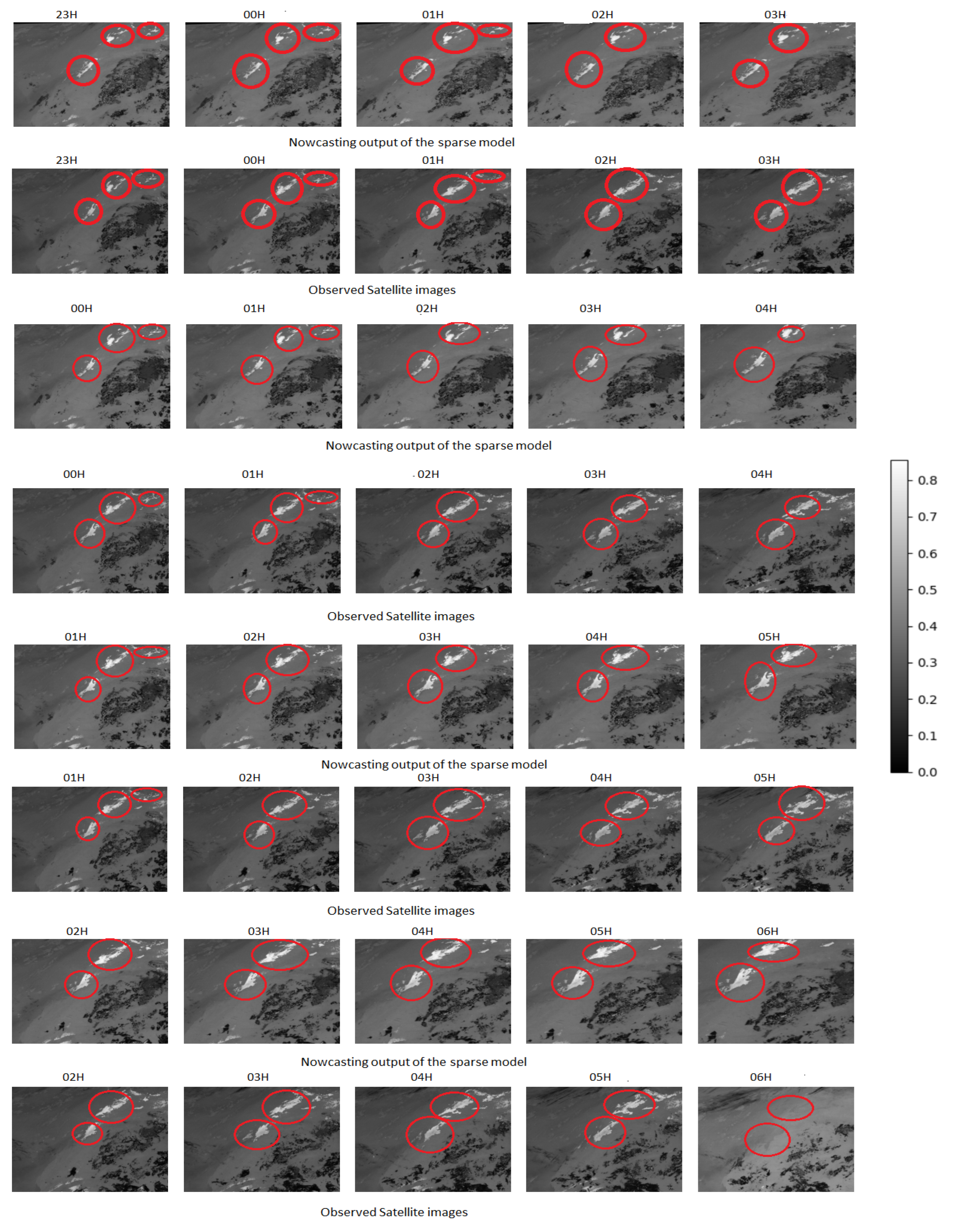



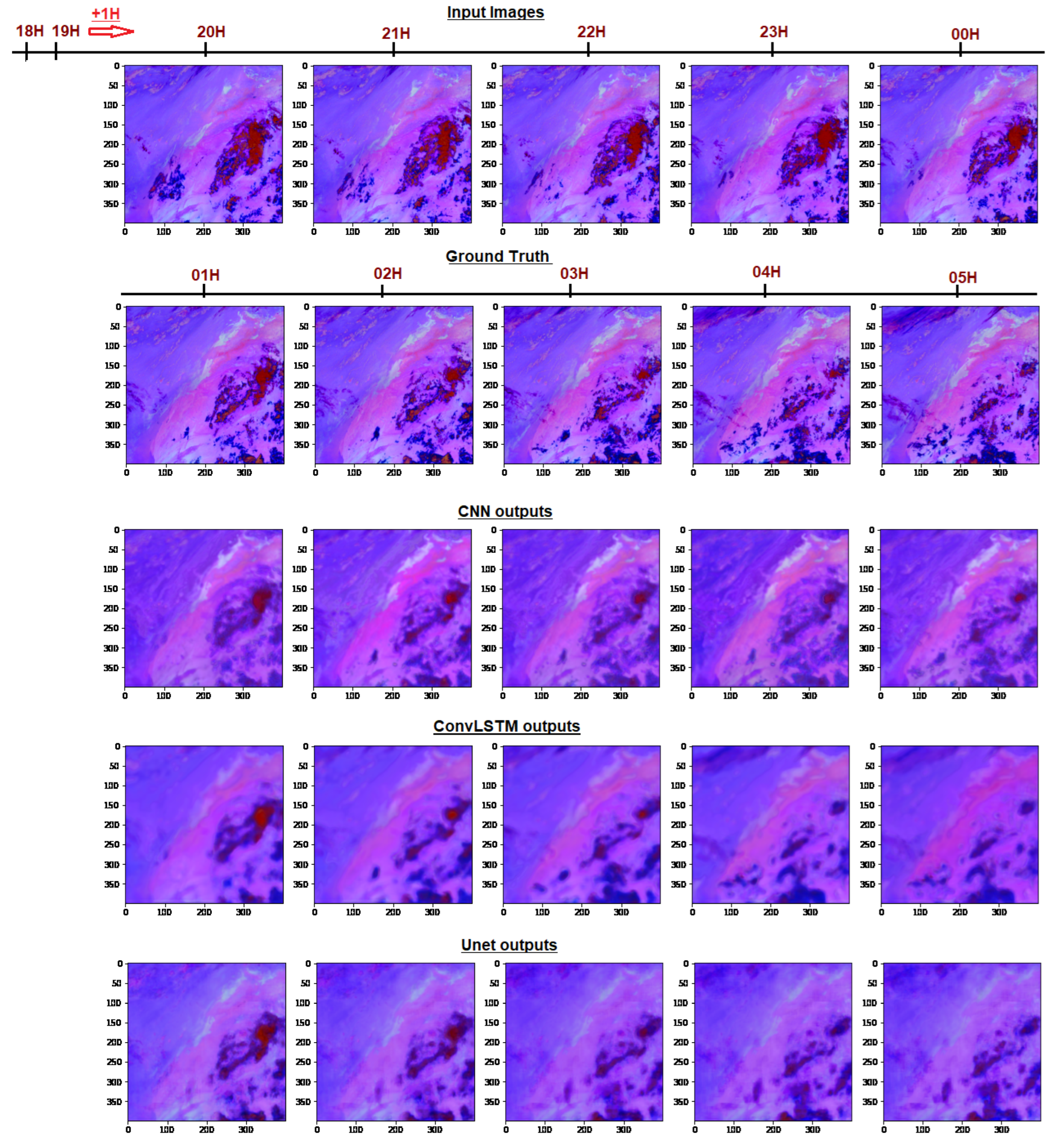
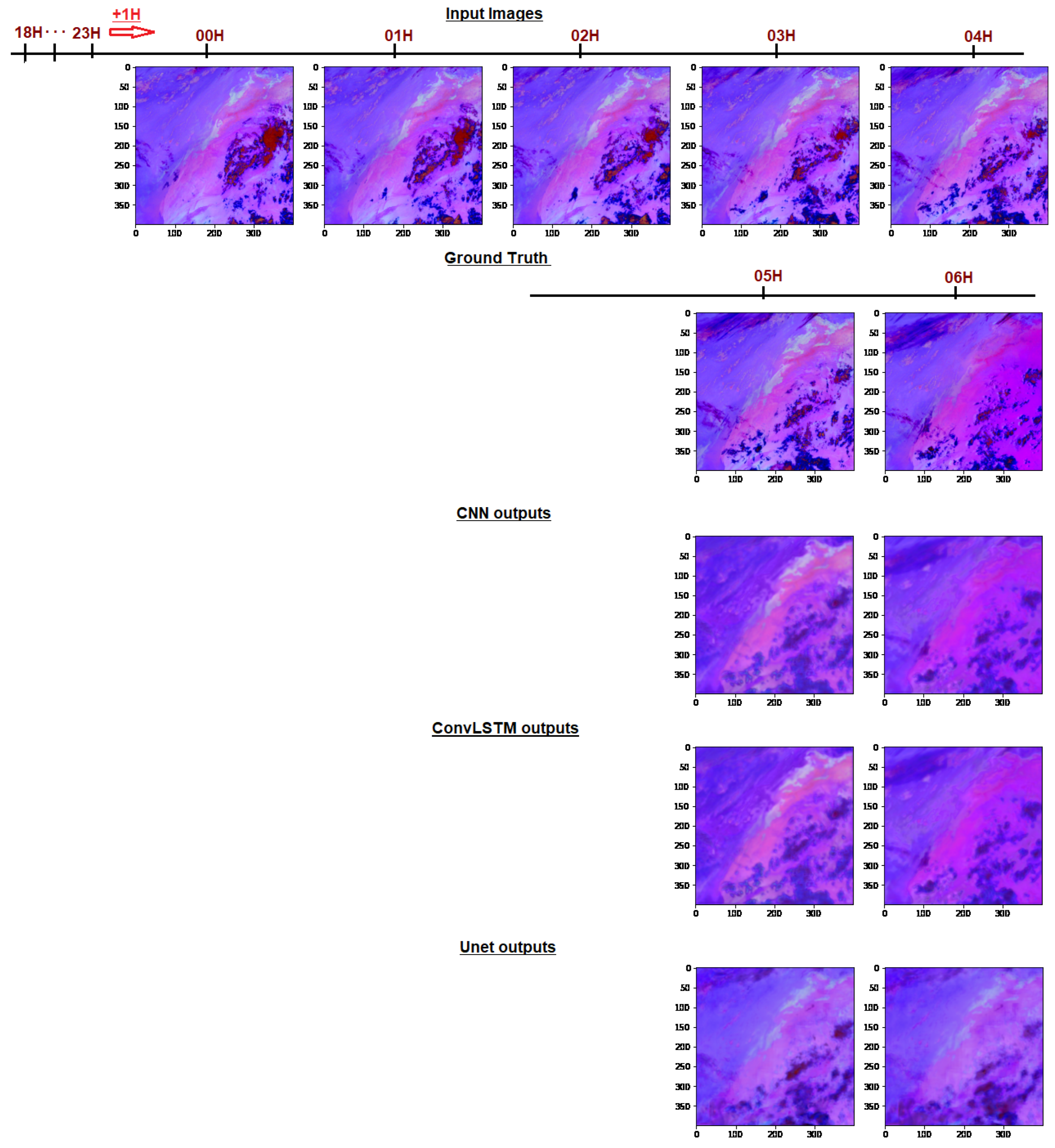
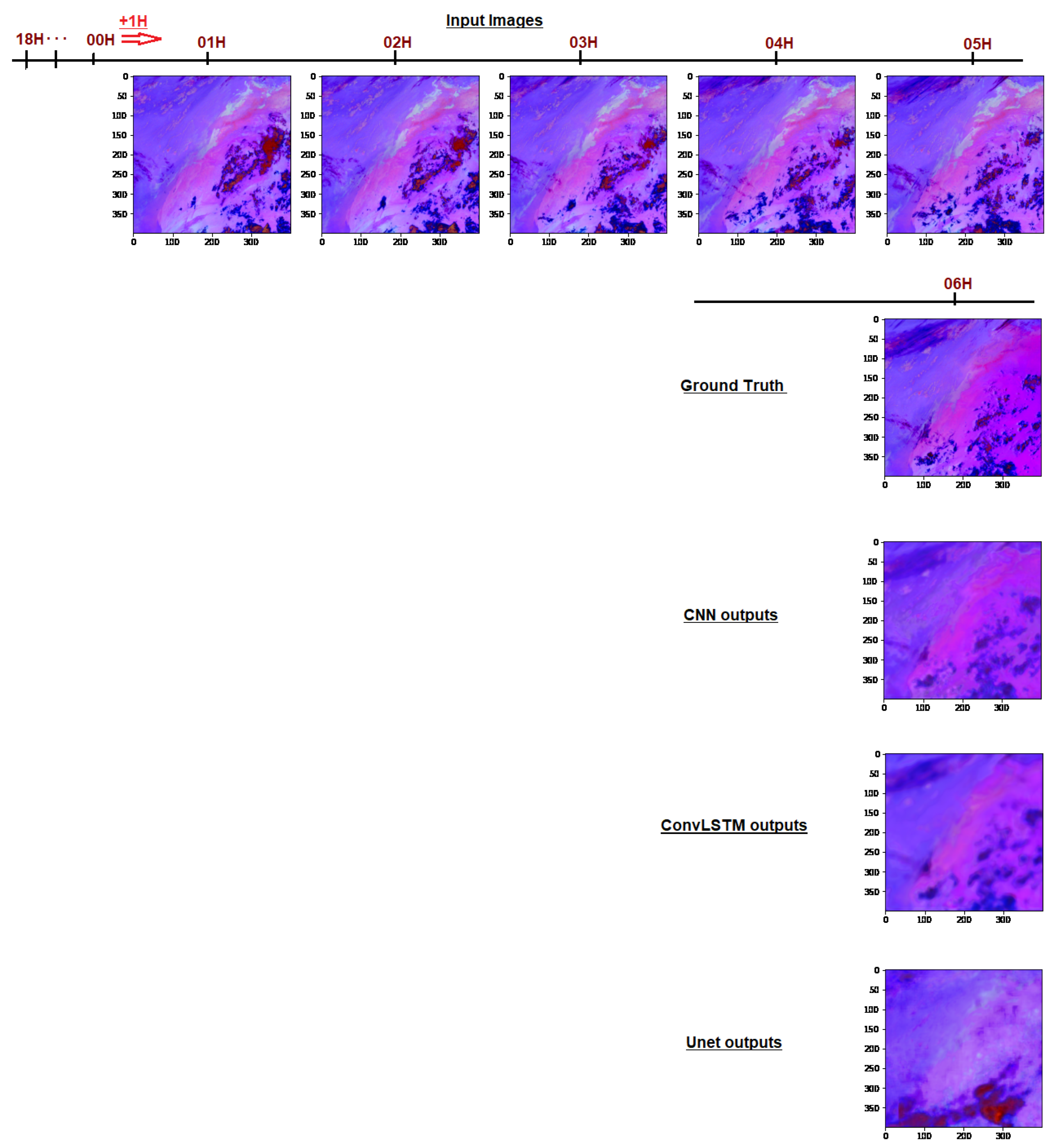
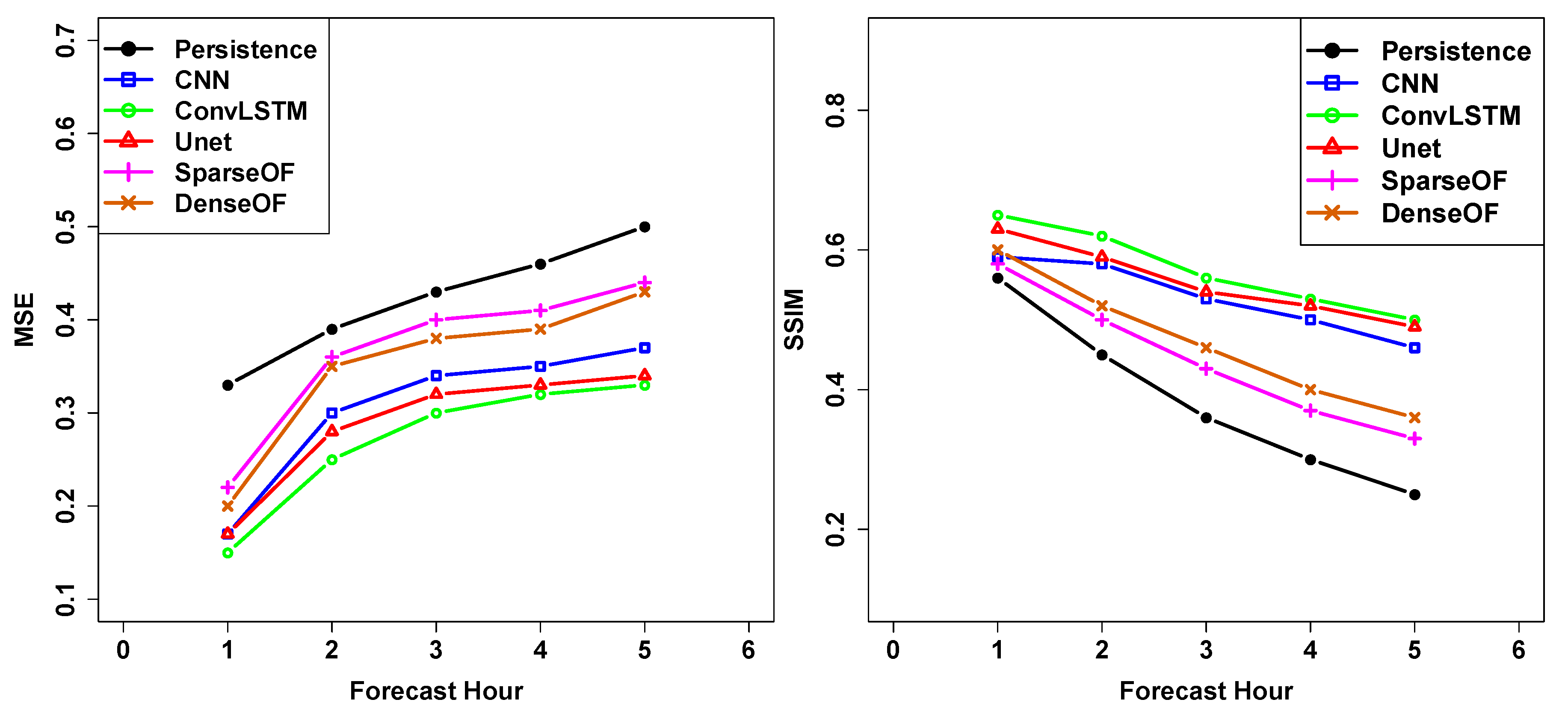
| MSE | SSIM | |
|---|---|---|
| Persistence | 0.422 ± 0.065 | 0.384 ± 0.123 |
| SparseOF | 0.366 ± 0.086 | 0.442 ± 0.100 |
| DenseOF | 0.350 ± 0.089 | 0.468 ± 0.095 |
| CNN | 0.306 ± 0.080 | 0.532 ± 0.054 |
| Unet | 0.288 ± 0.070 | 0.554 ± 0.056 |
| ConvLSTM | 0.270 ± 0.074 | 0.572 ± 0.062 |
Disclaimer/Publisher’s Note: The statements, opinions and data contained in all publications are solely those of the individual author(s) and contributor(s) and not of MDPI and/or the editor(s). MDPI and/or the editor(s) disclaim responsibility for any injury to people or property resulting from any ideas, methods, instructions or products referred to in the content. |
© 2023 by the authors. Licensee MDPI, Basel, Switzerland. This article is an open access article distributed under the terms and conditions of the Creative Commons Attribution (CC BY) license (https://creativecommons.org/licenses/by/4.0/).
Share and Cite
Bari, D.; Lasri, N.; Souri, R.; Lguensat, R. Machine Learning for Fog-and-Low-Stratus Nowcasting from Meteosat SEVIRI Satellite Images. Atmosphere 2023, 14, 953. https://doi.org/10.3390/atmos14060953
Bari D, Lasri N, Souri R, Lguensat R. Machine Learning for Fog-and-Low-Stratus Nowcasting from Meteosat SEVIRI Satellite Images. Atmosphere. 2023; 14(6):953. https://doi.org/10.3390/atmos14060953
Chicago/Turabian StyleBari, Driss, Nabila Lasri, Rania Souri, and Redouane Lguensat. 2023. "Machine Learning for Fog-and-Low-Stratus Nowcasting from Meteosat SEVIRI Satellite Images" Atmosphere 14, no. 6: 953. https://doi.org/10.3390/atmos14060953
APA StyleBari, D., Lasri, N., Souri, R., & Lguensat, R. (2023). Machine Learning for Fog-and-Low-Stratus Nowcasting from Meteosat SEVIRI Satellite Images. Atmosphere, 14(6), 953. https://doi.org/10.3390/atmos14060953







